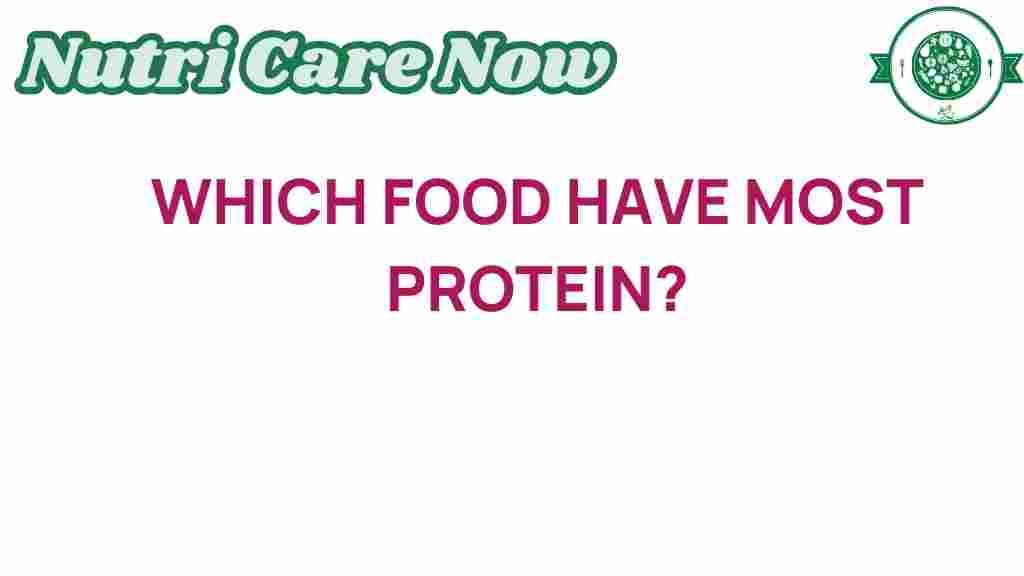Unveiling the Top Protein-Packed Foods: A Nutritional Quest for Protein-Rich Foods
In today’s health-conscious world, understanding the importance of protein-rich foods is essential for anyone looking to improve their nutrition, promote wellness, and achieve their fitness goals. Whether you’re a seasoned athlete or simply someone aiming for healthier dietary choices, focusing on protein can make a significant difference in your muscle building and overall health. This article will guide you through the best protein-packed foods, meal planning tips, and how to incorporate these foods into your daily diet.
What are Protein-Rich Foods?
Protein-rich foods are those that contain high levels of protein, which is a vital macronutrient necessary for building and repairing tissues, making enzymes and hormones, and supporting overall health. Foods high in protein can come from both animal and plant sources, making it easy to find suitable options for various dietary preferences.
Benefits of Protein-Rich Foods
Including protein-rich foods in your diet can offer numerous benefits, such as:
- Muscle Building: Protein is crucial for muscle repair and growth, making it essential for anyone involved in fitness.
- Satiety: High-protein meals can help you feel fuller for longer, aiding in weight management.
- Metabolic Boost: Protein requires more energy to digest compared to fats and carbohydrates, which can enhance your metabolic rate.
- Improved Recovery: After intense workouts, protein aids in muscle recovery and reduces soreness.
Top Protein Sources for Healthy Eating
When it comes to choosing protein-rich foods, variety is key. Below, we outline some of the best food sources of protein, categorized into animal and plant-based options.
Animal-Based Protein Sources
- Chicken Breast: A lean source of protein, ideal for muscle building.
- Turkey: Another lean meat that is rich in protein and low in fat.
- Fish: Options like salmon and tuna are not only high in protein but also provide essential omega-3 fatty acids.
- Eggs: A complete protein source, eggs are versatile and packed with nutrients.
- Dairy Products: Greek yogurt, cottage cheese, and milk are excellent sources of protein and calcium.
Plant-Based Protein Sources
- Legumes: Lentils, chickpeas, and black beans are not only high in protein but also rich in fiber.
- Nuts and Seeds: Almonds, peanuts, chia seeds, and hemp seeds provide protein along with healthy fats.
- Whole Grains: Quinoa and oats are great sources of plant-based protein.
- Tofu and Tempeh: These soy-based products are excellent protein sources for vegetarians and vegans.
- Seitan: Made from gluten, seitan is a popular protein-rich meat substitute.
Meal Planning with Protein-Rich Foods
To effectively incorporate protein-rich foods into your diet, meal planning is crucial. Here are some steps to ensure you’re getting enough protein daily:
Step-by-Step Process for Meal Planning
- Assess Your Protein Needs: Determine how much protein you need based on your age, activity level, and fitness goals. Generally, aim for 0.8 grams of protein per kilogram of body weight, or more for muscle building.
- Choose Your Protein Sources: Select a variety of protein-rich foods from both animal and plant sources to ensure a balanced intake.
- Create a Weekly Menu: Plan meals that include protein at each sitting. For example, include eggs for breakfast, chicken or tofu for lunch, and fish or legumes for dinner.
- Prep in Advance: Prepare meals in advance to save time and ensure that you stick to your protein goals.
- Monitor Your Intake: Keep track of your protein consumption to ensure you meet your daily goals.
Sample Meal Plan
Here’s a simple sample meal plan to help you get started:
- Breakfast: Scrambled eggs with spinach and whole grain toast.
- Snack: Greek yogurt with mixed berries and a sprinkle of nuts.
- Lunch: Grilled chicken salad with quinoa, mixed greens, and a vinaigrette dressing.
- Snack: Hummus with carrot and cucumber sticks.
- Dinner: Baked salmon with steamed broccoli and brown rice.
Troubleshooting Common Issues
When trying to incorporate more protein-rich foods into your diet, you may face some challenges. Here are a few tips to troubleshoot common issues:
1. Lack of Time
If you’re struggling to find time to prepare meals, consider batch cooking on weekends or using quick-cooking methods like stir-frying or grilling.
2. Boredom with Protein Sources
Mix things up by experimenting with different recipes and flavor profiles. Try marinating your proteins or adding spices to enhance flavor.
3. Dietary Restrictions
If you have dietary restrictions, look for alternative protein sources. For example, if you’re lactose intolerant, opt for lactose-free dairy products or plant-based yogurts. If you’re vegan, focus on legumes, nuts, and grains.
4. Cost Concerns
Protein sources can vary in cost. Look for sales, buy in bulk, or choose less expensive cuts of meat, like chicken thighs instead of breasts, to save money.
Conclusion: Embrace Protein-Rich Foods for a Healthier Lifestyle
Incorporating protein-rich foods into your diet is a beneficial step toward achieving your nutrition and fitness goals. By understanding the various food sources of protein, planning your meals effectively, and troubleshooting any challenges, you can enhance your overall wellness and support your muscle building efforts. Remember, healthy eating is about balance and variety, so explore different protein options and enjoy the journey to a healthier you.
For more tips on meal planning and healthy eating, check out this resource.
For more information on dietary choices and nutrition, visit this guide.
This article is in the category Diet and created by NutriCareNow Team
